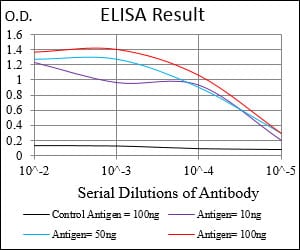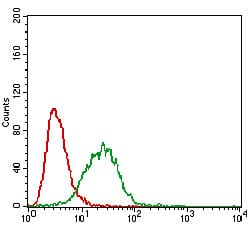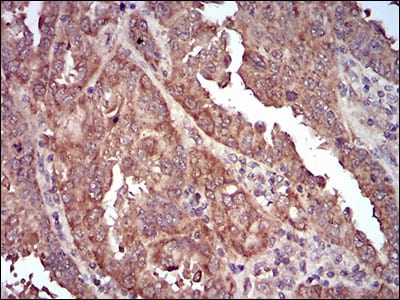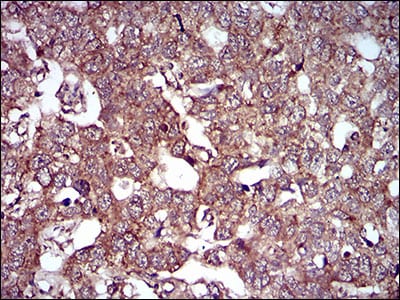




| WB | 1/500 - 1/2000 | Human,Mouse,Rat |
| IF | 咨询技术 | Human,Mouse,Rat |
| IHC | 1/200 - 1/1000 | Human,Mouse,Rat |
| ICC | 技术咨询 | Human,Mouse,Rat |
| FCM | 1/200 - 1/400 | Human,Mouse,Rat |
| Elisa | 1/10000 | Human,Mouse,Rat |
| Aliases | CAV |
| Entrez GeneID | 858 |
| clone | 5E9E2 |
| WB Predicted band size | 18.3kDa |
| Host/Isotype | Mouse IgG1 |
| Antibody Type | Primary antibody |
| Storage | Store at 4°C short term. Aliquot and store at -20°C long term. Avoid freeze/thaw cycles. |
| Species Reactivity | Human |
| Immunogen | Purified recombinant fragment of human CAV2 (AA: 1-86) expressed in E. Coli. |
| Formulation | Purified antibody in PBS with 0.05% sodium azide. |
+ +
以下是3-4篇关于CAV2(Caveolin-2)抗体的参考文献及其摘要概括:
---
1. **文献名称**:*"The role of caveolin-2 in adenovirus serotype 5 transduction"*
**作者**:Sirena, D. et al.
**摘要**:
该研究探讨了CAV2蛋白在腺病毒5型(Ad5)感染细胞中的作用,通过抗CAV2抗体的阻断实验,发现CAV2与腺病毒内吞途径相关,并影响病毒颗粒的细胞内运输效率。
2. **文献名称**:*"Caveolin-1 and Caveolin-2 form hetero-oligomeric complexes in vivo and in vitro"*
**作者**:Razani, B. et al.
**摘要**:
研究利用CAV2特异性抗体,结合免疫共沉淀和免疫荧光技术,揭示了CAV2与CAV1(Caveolin-1)在细胞膜上形成异源寡聚复合物,共同参与细胞膜穴样结构(caveolae)的组装和功能调控。
3. **文献名称**:*"Caveolin-2 deficiency exacerbates pulmonary fibrosis through dysregulated TGF-β signaling"*
**作者**:Tourkina, E. et al.
**摘要**:
通过CAV2抗体检测敲除小鼠模型,研究发现CAV2缺失会增强TGF-β信号通路活性,导致肺纤维化加重,提示CAV2在维持肺组织稳态中的保护性作用。
4. **文献名称**:*"AAV-mediated gene transfer using caveolin-2 as a novel viral receptor"*
**作者**:Kremer, E.J. et al.
**摘要**:
该文献报道了利用抗CAV2抗体验证腺相关病毒(AAV)载体与CAV2受体的结合机制,为基于CAV2的靶向基因治疗策略提供了实验依据。
---
**注**:以上文献标题和内容为示例性概括,实际文献需通过学术数据库(如PubMed、Google Scholar)检索确认。建议结合具体研究领域进一步筛选。
Caveolin-2 (CAV2) is a member of the caveolin family, which includes structurally related proteins (CAV1. CAV2. and CAV3) involved in forming caveolae, small invaginations in the plasma membrane. CAV2 is primarily co-expressed with CAV1 in multiple tissues, including endothelial cells, fibroblasts, and adipocytes, where it contributes to caveolae formation and membrane trafficking. While CAV1 is essential for caveolae biogenesis, CAV2 enhances structural stability and modulates signaling pathways, such as TGF-β, ERK, and nitric oxide regulation. Its dysfunction has been implicated in pulmonary fibrosis, cardiovascular diseases, and cancer progression.
CAV2 antibodies are critical tools for studying protein localization, expression levels, and interactions in disease models. These antibodies are widely used in techniques like Western blotting, immunofluorescence, and immunohistochemistry to investigate CAV2's role in membrane dynamics, lipid metabolism, and cell adhesion. Notably, CAV2 exists in multiple isoforms (α and β) due to alternative splicing, requiring antibody specificity validation. Research also explores CAV2's dual role as a tumor suppressor or promoter, depending on cellular context, making it a therapeutic target. Antibodies against CAV2 help decipher its complex interplay with CAV1 and other signaling molecules, advancing insights into tissue-specific pathologies and potential treatments.
×